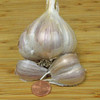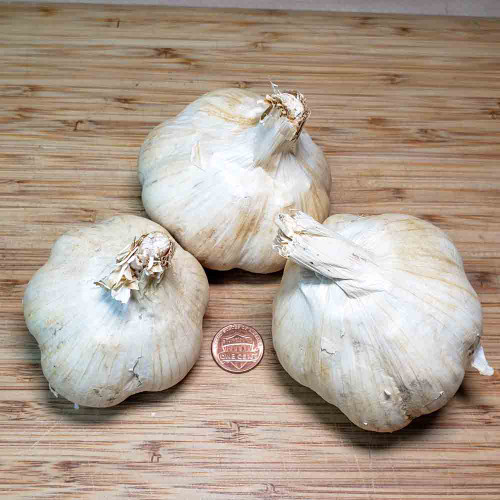Description
Amish Garlic - Treasured for Generations
Named for the German and Swiss Mennonite brethren who brought their favorite bulbs along from their homelands to America around the 1860s to 1880s and has been grown here ever since.
Our Amish garlic is a hardneck Rocambole variety that has been hand-grown in Wisconsin for generations by the Amish communities. This is a rich, spicy-hot, strongly flavored type, forming a single layer of cloves around a central stalk.
Rocambole garlic varieties are legendary for their complex, robust, full flavor, often referred to as having “true garlic flavor”. The most well-known and thus most widely grown of the hardneck varieties.
Details
Averages 8 – 10 large cloves in 2 inch or larger bulbs with purplish-brown thin papery skins. Rocambole types do not store as long as others, but Amish keeps longer than others – usually four to six months.
Uses
Amish is a vigorous grower with large foliage that is very popular for roasting, cooking and drying for garlic powder. Grows better in cooler or cold winters and is harvested in early to mid-summer.
What is Hardneck Garlic?
Garlic is divided into two main types – hardneck and softneck – based on whether or not each variety develops flower stalks, the hardiness, clove formation pattern, and flavor.
The “neck” in the name refers to the long flowering stem – called a scape – that grows upward from the bulb, only found in hardnecks. Also called garlic spears, stems or shoots, they are cut while they are still young and tender and used as a vegetable and a seasoning due to their fresh, delicate garlic flavor. Slowly but surely scapes are gaining in popularity. Cutting the scapes also helps the bulb grow larger, better-developed cloves.
The garlic found in supermarkets or grocery stores is usually softneck – Artichoke is the variety for sale as bulbs and Silverskin is braided.
Hardneck garlic has a more complex flavor profile, being richer, spicier, and generally more ‘garlicky’ with subtle flavors reflecting where it was grown. The strength and character of the flavors vary, from mild purple stripes to musky porcelains to hot and spicy rocamboles.
Purple stripe and rocambole types are the hardiest, best for gardeners who live in the northern U.S. Gardeners living in mild climates should have good luck with porcelain varieties, especially if they vernalize, or pre-chill their garlic for 4-6 weeks before planting.
About Our Garlic
The best garlic you’ve ever tasted is grown in your own home garden, no matter if you live in the coldest reaches of Minnesota, Michigan, or Montana; or the heat of southern Florida, south Texas, or Arizona.
Here’s why-
Our grower for this strain – Jonas and his family – are Wisconsin Amish growing certified organic garlic that has been in their extended family for years. They know their garlic better than anyone we’ve talked to, and are incredibly involved and hands-on throughout the entire growing process - from planting to weeding to harvesting and dry-down. Every bulb we offer has been handled multiple times by Jonas or his family.
Their work is done by hand and horsepower, creating a slower pace where they nurture and cultivate with more care and knowledge than larger farms with mechanical equipment. They carefully select the best garlic for next year’s planting, nurturing their garlic strains to ensure increasingly better quality each season.
They put in the time, effort, and work so you can have the benefit of the most vigorous, best-tasting garlic you’ve ever had – no matter where you garden!
Our garlic is grower direct, not from a warehouse or broker who treats them as just another commodity crop!
As a bonus, their garlic is certified organic.
The common myth is that hardneck garlic just won’t grow in warmer climates, but we’ve proven that you can. Our friend and long-time customer Lekoma had this to say about our Music variety:
"Living in central FL, I asked Stephen if he had any garlic that would grow well here. He recommended the Music garlic. It shipped earlier than other garlic we ordered and we were able to vernalize, refrigerate, it for about 12 weeks before planting. It did better than some of the softneck varieties we grew. I was so impressed, Music from Terroir Seeds is now a standard when we order our seed garlic."
Growing Tip
Minimize your spring weeding by planting a cover crop of cereal oats in the fall - about a week after planting the garlic - and letting the oats mature until the first frost kills them, creating a thick layer of beneficial mulch. The oat residue crowds out early spring weeds while adding needed nutrients for the maturing garlic.
Because of their short roots, garlic can’t compete very well with weeds, so you must either pull the weeds or prevent them from growing in the first place. Oats give the additional benefit of providing additional nutrients to the garlic right as they resume growing after the winter, making for bigger and tastier bulbs.
Our article - Grow Great Hardneck Garlic at Home - walks you through the details of how to grow the best and most delicious garlic you’ve ever had!
Learn More
Shipping Restrictions
U.S. shipping only, Cannot ship to certain counties in Washington or Idaho
From the soil to the seed to the food you eat - we'll help you grow your best garden!
1 Review
-
Amish Garlic
I grew this for the first time this year. I planted in October, cut scapes in early July and harvested in late July. Very easy to peel skin, good sized bulbs and cloves; flavor is delicious!



















